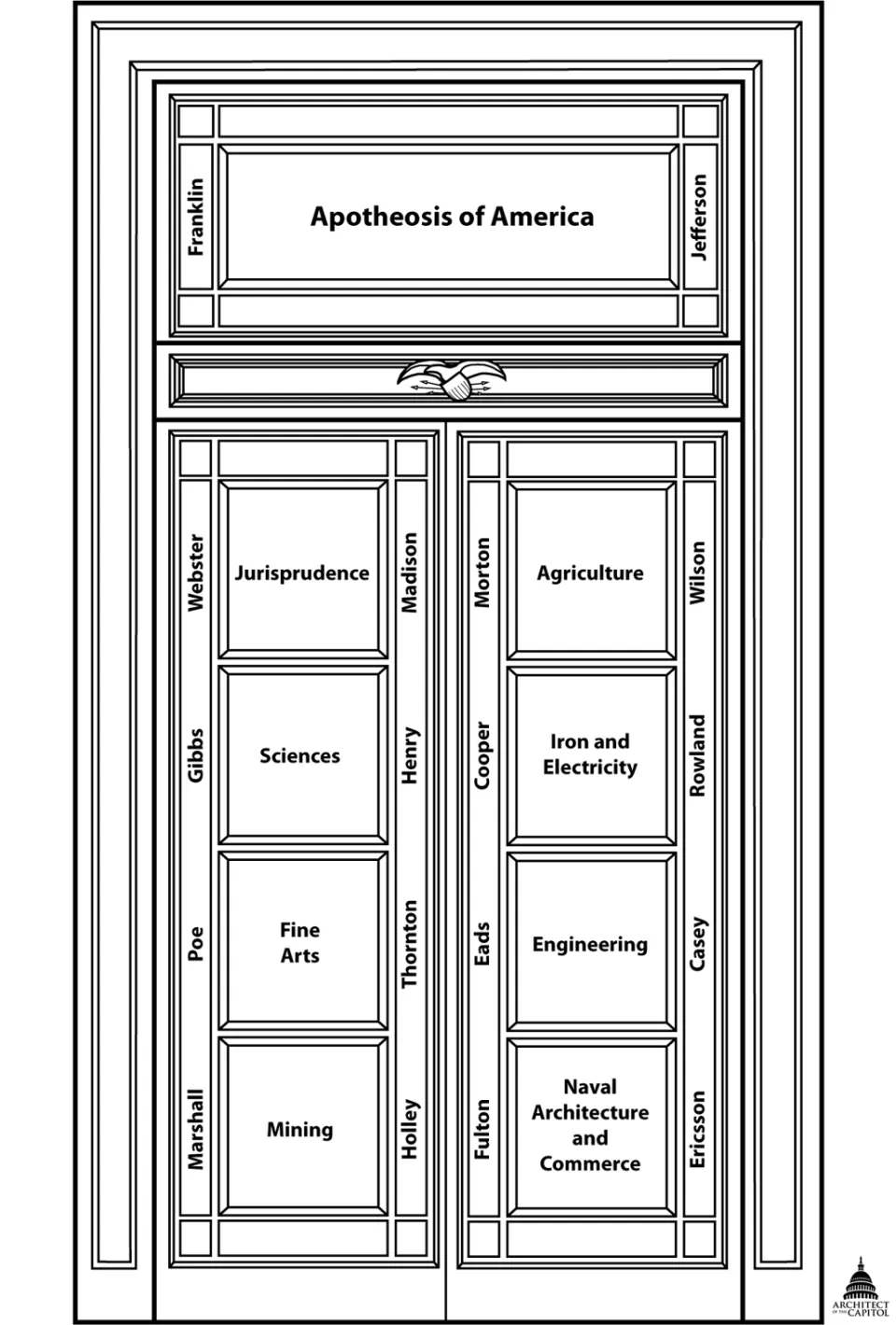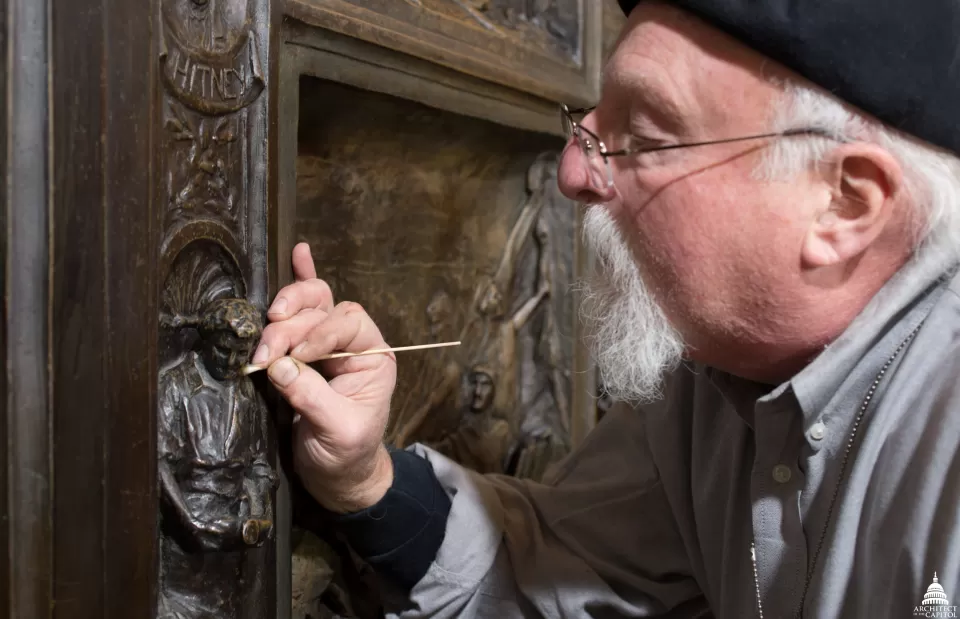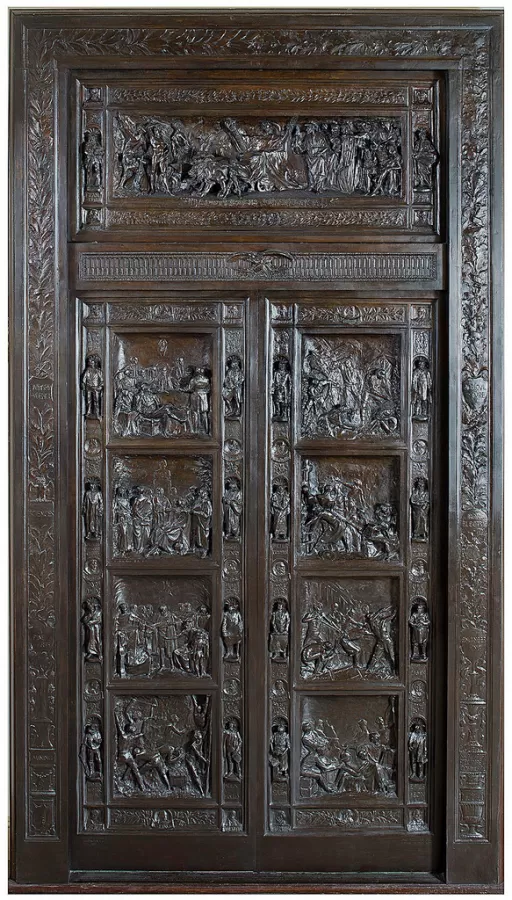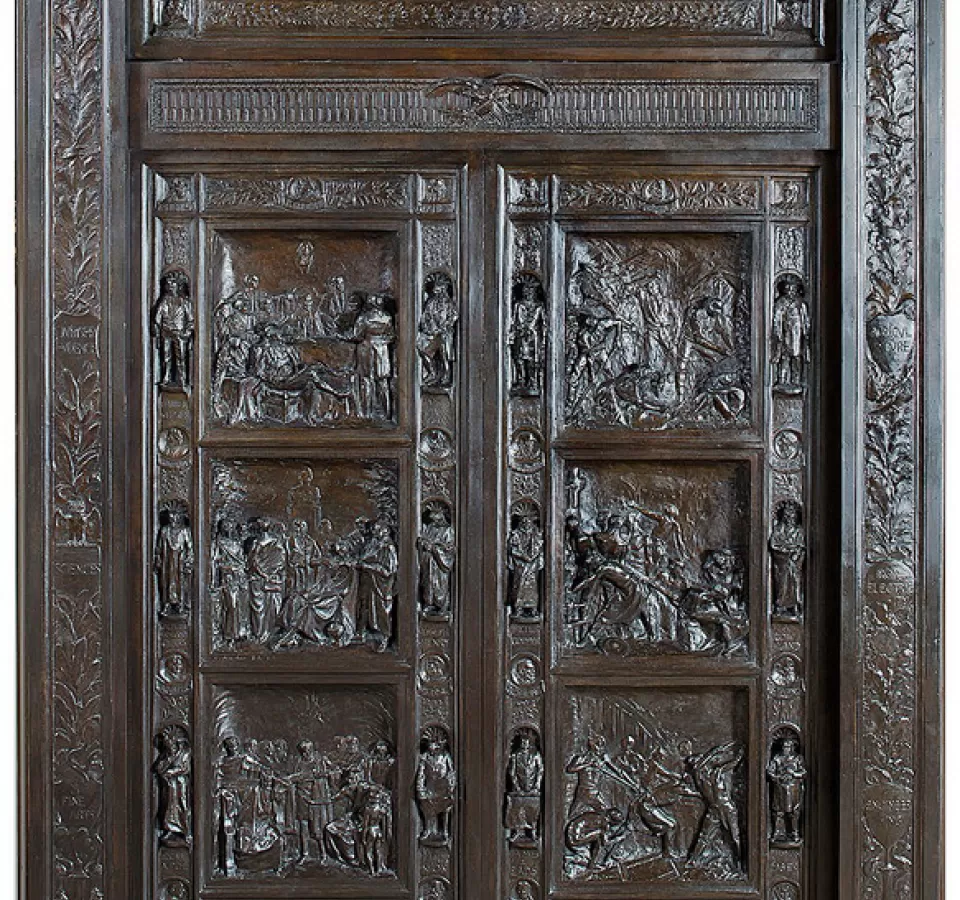Highlights
The bronze Amateis Doors are on display in the House Wing of the U.S. Capitol, across from the Bulfinch stairway near the Memorial Door entrance. The doors are cast in relief ranging from very low to high and consist of a transom, two valves and a surrounding frame.
The transom, titled "Apotheosis of America," depicts an allegorical figure of America surrounded by figural representations of education, architecture, painting, literature, music, sculpture, commerce, mining and industry. In the valves below, Amateis created panels with scenes of many of these subjects as well as jurisprudence, sciences, agriculture, iron and electricity, and engineering. Bordering the transom and panels are eighteen portrait figures and twenty-eight medallions of people noted for their work in the fields represented in the adjacent scenes. The ornamental frame consists of oak and laurel leaves, symbolizing strength and victory, and the names of the subjects of the panels appear in relief in a variety of decorative motifs.
Description of Subjects
Transom
America is seated in a chariot drawn by two lions led by a child, symbolizing the superiority of intellect over brute strength. Surrounding America are figural representations of education, architecture, painting, literature, music, sculpture, commerce, mining, and industry. The words "Apotheosis of America" appear in a banner below. Statuettes of Benjamin Franklin and Thomas Jefferson flanking the transom, and in the four corners are portrait medallions of George Peabody, financier of educational institutions; philosopher Ralph Waldo Emerson; educator Horace Mann; and philanthropist Johns Hopkins. Below the center of the transom, above the valves, appears an American eagle clutching arrows and the shield of the United States.

Left Valve
- Jurisprudence
The scene depicts Chief Justice John Marshall, located at the center, presiding over a meeting of the Supreme Court that decided the case of Marbury v. Madison. A bust of George Washington appears directly above Marshall. Amateis took this case of the supremacy of the judicial over the executive power as the highest expression of jurisprudence. Statuettes of Daniel Webster and James Madison flank the scene, and the subjects of the portrait medallions are lawyer Rufus Choate; Chief Justice Roger B. Taney; and patriot Patrick Henry. - Science
This scene depicts an imaginary gathering of scientific thinkers throughout history. The statuettes represent chemist Oliver W. Gibbs and physicist Joseph Henry. Geologist James D. Dana; astronomer Simon Newcomb; Alexander Graham Bell, inventor of the telephone; and Samuel F.B. Morse, inventor of the telegraph, are represented in the medallions. Amateis signed the doors "L. Amateis Wash D.C." at the bottom of this panel. - Fine Arts
In the Fine Arts panel are historic figures from literature and music; among them are the blind poet Homer, with his guide; Shakespeare; and Beethoven. Above them is the flying figure of Genius. Statuettes depict writer Edgar Allen Poe and William Thornton, the first architect of the U.S. Capitol. Portrait painter Gilbert Stuart and sculptor Henry Kirke Brown are represented in the medallions. - Mining
Figures work in a mine, swinging pick axes and hammers and erecting timbers. The statuettes flanking the scene represent James W. Marshall, discoverer of gold in California; and Alexander L. Holley, mining engineer. Below are medallions of engineer E.B. Case; industrialist Abram Hewitt; and geologist Clarence King.
Right Valve
- Agriculture
This scene depicts the cultivation of land and the harvesting of crops. Details in the background include the figure carrying wheat and the waterwheel of a mill, where grain is processed. The statuettes depict Samuel G. Morton, physician and ethnologist; and James Wilson, agriculturist and Secretary of Agriculture. Medallions are of Senator Justin S. Morrill and agricultural chemists John Pitkin Norton and Benjamin Bussey. - Iron and Electricity
In this panel, figures are shown operating machinery and studying plans. The statuettes are of philanthropist Peter Cooper; and physicist Henry A. Rowland. The medallions show Matthias W. Baldwin, an inventor and manufacturer of locomotives, and Thomas A. Edison, inventor. - Engineering
Workers are shown laying railroad tracks, and in the background stands a feat of engineering, an iron bridge. The statuettes are James B. Eads, builder of the St. Louis Railroad; and engineer Thomas L. Casey. The medallions are of John A. Roebling, engineer of the Brooklyn Bridge; and Edwin A. Stevens, of transcontinental railroad fame. - Naval Architecture and Commerce
A figure symbolizing Naval Architecture shows Commerce and Agriculture the places on a globe where they can sell their wares. The globe is held by a youth. A sailor holds a flag surmounted by a liberty cap, significant of an open-door policy. Statuettes portray Robert Fulton, inventor of the steamboat, and John Ericsson, designer of the ironclad ship Monitor. Medallions depict Eli Whitney, inventor of the cotton gin; Elias Howe, inventor of the sewing machine; John C. Fremont, the "Pathfinder"; Cyrus W. Field, financier of the Atlantic Cable; and naval constructor John Lenthall.
History
In March 1901, legislation was passed to appropriate funds for the Architect of the Capitol to prepare and submit to Congress plans and estimates for reconstructing the central portion of the U.S. Capitol Building, a project that would include refacing the West Front in marble. In 1903, Elliott Woods, superintendent of the U.S. Capitol and Grounds, started to explore the possibility of placing grand bronze doors, similar to those at the main East Front entrances, on the new façade. He began exchanging ideas with Louis Amateis, who founded the School of Architecture and Fine Arts at Columbian University (today The George Washington University) and was chairman of its Fine Arts Department, about possible designs and subjects.
Woods and Amateis had a general idea of the subjects to be depicted in the doors, but the final choice of scenes and selection of details were worked out through a series of drawings and models, including a full-size color rendering of the doors placed in the doorway of the West Front entrance. Woods continued to have an active role through the course of the commission. He assembled a committee of prominent architects and sculptors, including architect Thomas Hastings of the firm Carrère and Hastings and sculptor Daniel Chester French, to review Amateis’s work. The full-size plaster model of the doors was approved in 1908. The casting was put out to bid the following year and the contract was awarded to Jno. Williams, Inc., with The Roman Bronze Works as subcontractor. The bronze doors were completed in 1910.
By the time the doors were cast, however, the reconstruction of the West Front had not been authorized. Amateis unsuccessfully attempted to persuade Woods to place the doors in the existing West Front entrance anyway, arguing that when the reconstruction eventually took place the doors could easily be taken down and later reinstalled. (In fact, the reconstruction was never authorized.) The doors were instead displayed at the Corcoran Gallery of Art from 1910 to 1914. They were lent for display to the Smithsonian Institution in February 1914 and exhibited at the new National Museum (now the National Museum of Natural History) until 1967. The doors were then returned to Congress and placed in storage until 1972, when they were installed in their current location across from the Bulfinch stairway near the Memorial Door entrance in the House Wing. Few doors are created to lead to nowhere, but that is exactly where these doors have always led.
Conservation

The first professional conservation of the doors was performed in February 2013. Dust, degraded coatings, and hand oils from people touching the doors were removed; the original patina color was restored; and a protective wax coating was applied.

